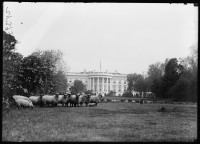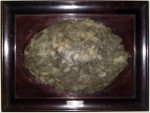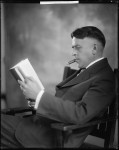 After President Woodrow Wilson declared war on Germany in April of 1917, his own family undertook to set an example of home front contributions to the war effort. Following the programs of future president Herbert Hoover, then head of the Food Administration, Woodrow’s wife Edith instituted fuel and food conservation measures like gasless Sundays, meatless Mondays and wheatless Wednesdays. They suspended White House entertaining and worked assiduously to raise money for the troops by organizing liberty bond rallies hosted by the likes of Charlie Chaplin, Douglas Fairbanks and Mary Pickford.
After President Woodrow Wilson declared war on Germany in April of 1917, his own family undertook to set an example of home front contributions to the war effort. Following the programs of future president Herbert Hoover, then head of the Food Administration, Woodrow’s wife Edith instituted fuel and food conservation measures like gasless Sundays, meatless Mondays and wheatless Wednesdays. They suspended White House entertaining and worked assiduously to raise money for the troops by organizing liberty bond rallies hosted by the likes of Charlie Chaplin, Douglas Fairbanks and Mary Pickford.
In 1918, they took that commitment to a whole new level of cuteness. Wilson purchased a flock of 18 sheep led by an ornery ram named Old Ike who was famous for chewing tobacco. He gnoshed on any cigar butt he could find. He was no fan of humans — White House staff and police were favorite targets for his head-butting wrath — but he was a fine leader of ewes and produced a mighty fleece.
( Interestingly, he wasn’t the first vicious ram to roam the White House lawns. Thomas Jefferson brought a large flock with him from Monticello in 1807 to continue the breeding program he had long been obsessed with. The leader of the flock was a four-horned Shetland ram who took aim at anyone attempting to take a short cut through the property back when that sort of thing was possible. In 1808 he felled William Keough, a Revolutionary War veteran who had fallen on hard times and was in Washington, D.C. to petition the President for a pension. Others were not so lucky. The ram actually killed a child. When he returned to Monticello, he killed two other rams and one of his own offspring. Finally in 1811 Jefferson had him put down.)
Interestingly, he wasn’t the first vicious ram to roam the White House lawns. Thomas Jefferson brought a large flock with him from Monticello in 1807 to continue the breeding program he had long been obsessed with. The leader of the flock was a four-horned Shetland ram who took aim at anyone attempting to take a short cut through the property back when that sort of thing was possible. In 1808 he felled William Keough, a Revolutionary War veteran who had fallen on hard times and was in Washington, D.C. to petition the President for a pension. Others were not so lucky. The ram actually killed a child. When he returned to Monticello, he killed two other rams and one of his own offspring. Finally in 1811 Jefferson had him put down.)
Wilson’s White House sheep released groundskeeping personnel so they could enlist, saved money on maintenance and raised money through wool sales. Here’s some footage of the flock trundling around the Executive Mansion grounds while Woodrow Wilson looks out the window at them.
[youtube=http://youtu.be/n6nhqFIIGR4&w=430]
The White House lawns turned out to make outstanding pasture land. The sheep feasted mightily on the sweet grasses, growing thick woolen pelts and making lots of adorable lambs to increase their numbers. They kept the lawns manicured and fertilized, and much like White House pets today, were widely popular with the American public. The sheep were also fundraisers of unparalleled efficacy. The animals with the best quality fleece were sheered and their wool sold at auction. The states each received a few fleeces to be auctioned off with the imprimatur of White  House Wool. The first sale in 1918 raised $30,000 for the Red Cross. The next year’s auction raised an extraordinary $52,823 for the Red Cross, an average of $1,000 a pound. To this day it remains the most expensive wool ever sold. Ike’s fleece, incidentally, sold for a mind-blowing $10,000 a pound.
House Wool. The first sale in 1918 raised $30,000 for the Red Cross. The next year’s auction raised an extraordinary $52,823 for the Red Cross, an average of $1,000 a pound. To this day it remains the most expensive wool ever sold. Ike’s fleece, incidentally, sold for a mind-blowing $10,000 a pound.
 The sheep outlasted the war. Newspapers reported that more than half the flock of 46 was sheered on May 24th, 1920, both to raise money for charity and to keep the sheep looking sharp so they didn’t mar the handsome prospect of the Pennsylvania Avenue-fronting North Lawn. That year 185 pounds of wool were sheered from the White House flock and donated to the Salvation Army. There were two more head in the flock by August when the White House sheep were decommissioned because the Shepherd in Chief had failed to secure the nomination of his party at the 1920 Democratic National Convention the month before.
The sheep outlasted the war. Newspapers reported that more than half the flock of 46 was sheered on May 24th, 1920, both to raise money for charity and to keep the sheep looking sharp so they didn’t mar the handsome prospect of the Pennsylvania Avenue-fronting North Lawn. That year 185 pounds of wool were sheered from the White House flock and donated to the Salvation Army. There were two more head in the flock by August when the White House sheep were decommissioned because the Shepherd in Chief had failed to secure the nomination of his party at the 1920 Democratic National Convention the month before.
 The flock retired to the Maryland farm of Lionel C. “Dick” Probert, chief of the Washington bureau of the Associated Press, who had himself played a pivotal but virtually unknown role in the United States’ entry into World War I. It was Probert who broke the story of the Zimmermann Telegram, the coded message sent by German Foreign Minister Arthur Zimmermann to the German Ambassador to Mexico, Heinrich von Eckhardt, instructing him to offer Mexico funding and territories in the US if it joined the war on the German side. The AP story, written without byline by Probert, went to press on March 1, 1917. It was a sensation, inciting widespread anti-German feeling all over the country. A month later, the US was at war with Germany.
The flock retired to the Maryland farm of Lionel C. “Dick” Probert, chief of the Washington bureau of the Associated Press, who had himself played a pivotal but virtually unknown role in the United States’ entry into World War I. It was Probert who broke the story of the Zimmermann Telegram, the coded message sent by German Foreign Minister Arthur Zimmermann to the German Ambassador to Mexico, Heinrich von Eckhardt, instructing him to offer Mexico funding and territories in the US if it joined the war on the German side. The AP story, written without byline by Probert, went to press on March 1, 1917. It was a sensation, inciting widespread anti-German feeling all over the country. A month later, the US was at war with Germany.
The White House sheep continued to thrive at Probert’s farm. By 1927, the year Old Ike shuffled off this mortal coil, the flock had increased to 75 head.
Interesting story! I had not known of the White House sheep. They ought to reinstitute the tradition, but would have to keep them out of Mrs. Obama’s vegetable garden!
Oh yes, all those delicious veggies would be hard to resist. They’d have to get a couple of border collies to stare the sheep down when they got too close, which would have the added bonus of being awesome.
Well, I always have thought that T. Jefferson was more than a little odd, not least in his personal priorities. A ram over a child’s life? I knew about Wilson’s sheep because some of my people were sheep raisers about that time and passed down the story. They were in the west, but here in Vermont, where I live now, sheep were a feature on the hillside pasture back of the State Capitol until relatively recently. I think basically because, well, this is Vermont and we’re proud of our sheep. There was quite an argument about removing the sheep when the state needed to add office space, and decided to use the grounds behind the statehouse in order to preserve the historic ambiance in front. We still do miss the sheep. Sorry the date escapes me when the addition was built, but I believe it was late 20th century. BTW, do you happen to know the breed of Wilson’s flock? I’m guessing Suffolk, would love to know for sure. Does anyone know if the flock is still extant, or descendents from it?
Jefferson, for all his genius in many fields, was an awful, awful businessman. He was always trying to think of new revenue streams to keep the creditors at bay. The sheep breeding program was one of his boondoggles, and he was so invested in it that it took the ram killing its own stock before Jefferson put a stop to the animal’s depredations. This wasn’t the first or the last time he tried and failed to turn a profit even at the expense of human life.
Wilson’s sheep were Shropshire Downs. I do not know if any of the White House flock’s descendants live today. After Probert’s death in 1937, the farm was sold to Harold Ickes, Secretary of the Interior under FDR. I would imagine the stock was part of the deal, but couldn’t find any specific references to the sheep. Jane Ickes sold most of the farm — 190 acres out of 250 — to real estate developers in 1971, and almost all of the rest was a subdivision by the end of the 1980s .The beautiful home Probert built, a customized version of a Sears Roebuck mail-order catalog house, now stands on a relatively modest 3.5 acre plot. There are great pictures of the Sears home in this 2011 real estate listing.
That is so cool about Vermont’s proud tradition of sheep at the Capitol. Bring back the sheep! Those delicious Vermont cheeses won’t make themselves.
Just too may jokes lurking in this one.
“led by an ornery ram named Old Ike who was famous for chewing tobacco. He gnoshed on any cigar butt he could find.”
THe ram had the cleanest intestines, I bet. tobacco is a great parisitide. Wonder if it’s as addictive in it’s digestive form.
He was certainly insistent on getting a regular supply of tobacco once he got a taste for it. According to the news article about his death, he was given a last tobacco meal and died chewing it.
the shear number of uses of the word
“sheered” is over- lambing…
:giggle:
I like it. Reminds me that there was a much more humble time in our past.